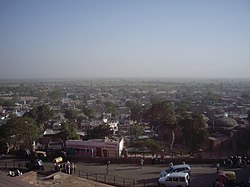Fatehpur Sikri
|
Fatehpur Sikri फ़तेहपुर सीकरी |
|
|---|---|
| City | |

View of the modern Fatehpur Sikri
|
|
| Coordinates: 27°05′28″N 77°39′40″E / 27.091°N 77.661°ECoordinates: 27°05′28″N 77°39′40″E / 27.091°N 77.661°E | |
| Country | India |
| State | Uttar Pradesh |
| District | Agra |
| Population | |
| • Total | 28,757 |
| Time zone | IST (UTC+5:30) |
| Type | Cultural |
| Criteria | ii, iii, iv |
| Designated | 1986 (10th session) |
| Reference no. | 255 |
| UNESCO Region | Asia-Pacific |
Fatehpur Sikri (Hindi: फ़तेहपुर सीकरी, is a city in the Agra District of Uttar Pradesh, India. The city was founded in 1569 by the Mughal Emperor Akbar, and served as the capital of the Mughal Empire from 1571 to 1585, when it was abandoned. After his military victories over Chittor and Ranthambore, Akbar decided to shift his capital from Agra to a new location 23 miles (37 km) west south-west , to honour the Sufi saint Salim Chishti. Here, he commenced the construction of a planned walled city, which took the next fifteen years in planning and construction, with a series of royal palaces, harem, courts, a mosque, private quarters and other utility buildings. He named the city Fatehabad, with Fateh, a word of Arabic origin in Persian, meaning "victorious." It was later called Fatehpur Sikri. It is at Fatehpur Sikri that the legends of Akbar and his famed courtiers, the nine jewels or Navaratnas, were born. Fatehpur Sikri is one of the best preserved examples of Mughal architecture in India.
According to contemporary historians, Akbar took a great interest in the building of Fatehpur Sikri and probably also dictated its architectural style. Seeking to revive the splendours of Persian court ceremony made famous by his ancestor Timur, Akbar planned the complex on Persian principles. But the influences of his adopted land came through in the typically Indian embellishments. The easy availability of sandstone in the neighbouring areas of Fatehpur Sikri also meant that all the buildings here were made of the red stone. The Imperial Palace complex consists of a number of independent pavilions arranged in formal geometry on a piece of level ground, a pattern derived from Arab and central Asian tent encampments. In its entirety, the monuments at Fatehpur Sikri thus reflect the genius of Akbar in assimilating diverse regional architectural influences within a holistic style that was uniquely his own.
...
Wikipedia

